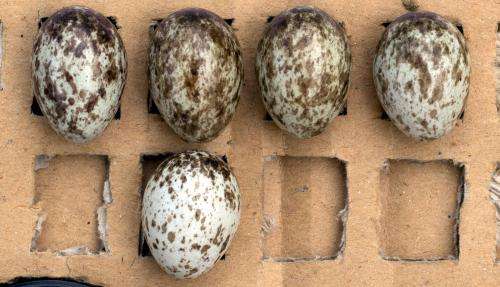How tree sparrows recognize foreign eggs in their nests

Many birds have reason to worry that the eggs in their nest might not be their own: birds often deposit eggs into other nests and it is not easy for parents to tell their eggs from others. Researchers at the University of Veterinary Medicine, Vienna have discovered that tree sparrows can recognise eggs deposited by other tree sparrows but do not always reject them. The results are published in the online journal Plos One.
Building a nest, laying and incubating eggs and taking care of a hungry brood are very demanding on birds´ energy budgets, so it is obviously in their interests to ensure that the young they are caring for are their own. Brood parasitism sometimes makes this a difficult proposition: strangers – either of their own kind or of another species – might want a free ride and deposit their eggs into ready-made nests. The reluctant "hosts" pay a high cost. At the very least, they waste energy on unrelated offspring, while at worst their own eggs or hatchlings are killed by parasitic chicks.
Motivation check
Strategies to avoid egg dumping vary from species to species. Birds might count eggs or recognize foreign eggs by variation in colour or size and if possible reject them. But recognizing foreign eggs is not always easy and not all species or individuals succeed. Some birds do not seem to discern even obvious differences, while some that do are physically unable to eject the strange eggs. Even when hosts manage to eject eggs from the nest, their motivation for doing so is unclear. Are they keeping the nest "sanitized" for their brood or are they attempting to prevent parasitism?
The tree sparrow (Passer montanus) seems to have evolved strong variation in egg colouration and size between clutches, probably to enhance its ability to discriminate parasitic eggs from its own. To test for the ability to recognise conspecific eggs, Herbert Hoi and colleagues at the Konrad Lorenz Institute of Ethology of the University of Veterinary Medicine, Vienna introduced both real eggs and cardboard models into the nests of tree sparrows. The scientists used flat objects to ensure the birds would easily be able to remove the fake "eggs" if they wanted to (flat objects are easier to grasp with the beak than round ones). To investigate which features made ejection more likely, they included model eggs with features that are not typical of tree sparrow eggs.
The researchers also checked for the sparrows' motivation for ejecting eggs by introducing the models either at the time of egg-laying or during incubation. "If the motivation is to defend against egg-dumping, we would expect egg ejection to happen largely when the females are laying eggs," explains Hoi. "If they do it during incubation, they probably just want to keep the nest clean for their hatchlings." In two related experiments, the researchers tested the consequences of adding eggs to 30 nest boxes during egg laying and to another 30 during incubation, first using real eggs and then using flat paper models.
Tree sparrows keep their nests clean
The birds removed foreign eggs from the nest in about a third of cases in the first experiment, although the remainder accepted and continued to incubate parasitic eggs. When flat models were used, 81% of the objects were quickly thrown out, regardless of the time of introduction. The results point to an anti-parasite behaviour, albeit an imperfect one. The birds sometimes seem to have a hard time ejecting foreign eggs with their beaks, although it is also possible that they do not always correctly identify them. "Our tests on motivation are interesting. The sparrows threw out foreign objects of a different size more often during the egg-laying stage but they were more careful to remove unusual white objects during the incubation stage," says Hoi. "This shows that avoidance of parasitism is a motivation but nest sanitation also plays a part because the sparrows probably think the white, non-round objects are egg sacks and broken shells, which are usually removed from the nest after the young hatch."
More information: Poláček M, Griggio M, Bartíková M, Hoi H (2013) "Nest Sanitation as the Evolutionary Background for Egg Ejection Behaviour and the Role of Motivation for Object Removal." PLoS ONE 8(11): e78771. DOI: 10.1371/journal.pone.0078771
Journal information: PLoS ONE
Provided by University of Veterinary Medicine -- Vienna



















